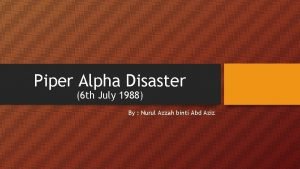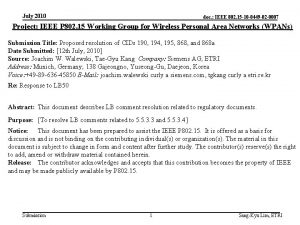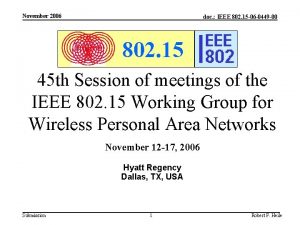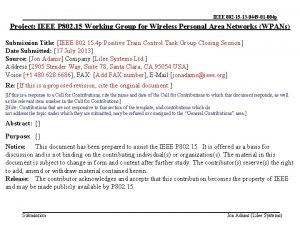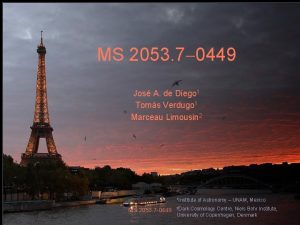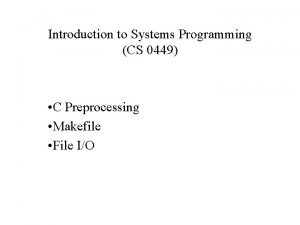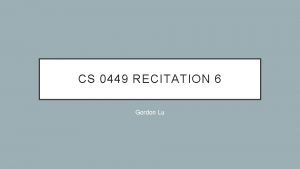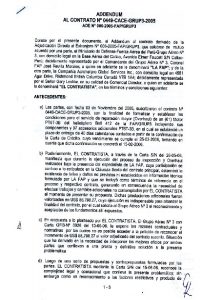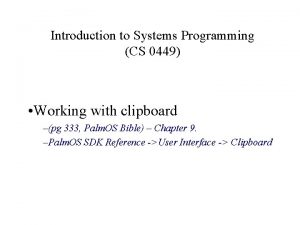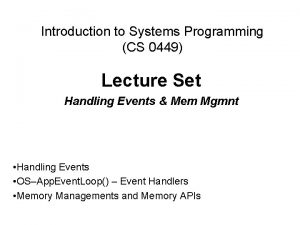July 2017 Doc IEEE 15 17 0449 00










![July 2017 Doc. : IEEE 15 -16 -0851 -00 -004 t References [1] Z. July 2017 Doc. : IEEE 15 -16 -0851 -00 -004 t References [1] Z.](https://slidetodoc.com/presentation_image_h/ad8aa0b9f8045ea885f24abcf1a386c7/image-11.jpg)

- Slides: 12

July 2017 Doc. : IEEE 15 -17 -0449 -00 -lpwa Evaluation on blind detection for 802. 15 Date: 2017 -7 -10 Authors: Name Ningbo Zhang Tingting Ding Submission Affiliations Beijing University of Posts and Telecommunications Address Phone Email Beijing, China nbzhang@bupt. edu. cn Beijing, China ttding@bupt. edu. cn Slide 1 BUPT

July 2017 Doc. : IEEE 15 -17 -0449 -00 -lpwa Motivation • In NOMA random access, SIC receiver is required to cancel interuser interferences at STA[1 -2] – SIC receiver requires diverse arrived power to distinguish multiplexing users. – To obtain the diverse arrived power, a power back-off scheme is proposed for uplink NOMA transmission. Submission Slide 2 BUPT

July 2017 Doc. : IEEE 15 -17 -0449 -00 -lpwa NOMA RA • Step 1: Peer discovery: This step is to discover neighbor paired STAs. • Step 2: NOMA group establishment: Select a group center and allocate the power back-off index. • Step 3: Channel detection: The group center sends preamble to detect the channel on behalf of NOMA group. • Step 4: Detection response: AP sends back the detection response to NOMA group STAs. • Step 5: Power back-off: NOMA group STA power back-off to guarantee diverse received power at AP. • Step 6: SIC reception and ACK: AP performs SIC receiver to cancel multi-STA interferences and sends back ACK/NACK. Submission Slide 3 BUPT

July 2017 Doc. : IEEE 15 -17 -0449 -00 -lpwa Multiple User Decoding at STA • Two Users are multiplexed – Near User: baseline arrived power – Far User: d. B lower than near user • AP decoding – For near user, AP direct decodes the message since the interference from far user is neglected. – For far user, AP first cancels the near user’s message and then decodes the far user’s message. Submission Slide 4 Fig. 1 SIC receiver at STA BUPT

July 2017 Doc. : IEEE xxxx-xx Performance of NOMA • (MMSE-SIC) receiver is performed at AP – The performance of NOMA degrades compared to OMA – There exists SNR threshold between the OMA RA and the NOMA RA for a target BLER. Taking as the target BLER, the SNR threshold is about 6. 3 d. B Submission Fig. 2 Performance of SIC receiver at STA Transport block size (TBS) : 100 bits Modulation order: QPSK The number of STAs in Group A: Two The number of STAs in Group B: Three Channel model: Extended pedestrian A (EPA) Difference of received power : 5 d. B Slide 5

July 2017 Doc. : IEEE 15 -17 -0449 -00 -lpwa Power Control for Uplink NOMA • The transmit power of the i-th User in a NOMA set is: Where is the maximum transmit power, is the target arrived power and is the path loss including distance-dependent path loss and lognormal shadowing. is the assigned resource unit. • Near user • Far User Submission Slide 6 BUPT

July 2017 Doc. : IEEE 15 -17 -0449 -00 -lpwa Simulation Results • Assumptions: Parameter Value Carrier 2. 4 GHz – - Distance between near user and AP Distance between far user and AP Distance between OMA user and AP Tb size Modulation order 23 d. Bm 10 meters 30 meters 100 bits QPSK 5 d. B Target data rate for near user and far user Target data rate for OMA user Submission Fig. 3 Sum rate simulation between OMA and NOMA • NOMA achieves significant gain at lower SNR region when the target data rate of OMA equals the sum of NOMA’s target data rate. • NOMA achieves almost double sum data rate more than OMA at higher SNR region when the target data rate of OMA is the same as NOMA UE. Slide 7 BUPT

July 2017 Doc. : IEEE xxxx-xx Hybrid RA for 802. 15 • Access mode selection – Received SNR at AP – where is the variance of noise and is the received power at AP. Fig. 4 Hybrid RA scheme Submission Slide 8

July 2017 Doc. : IEEE 15 -17 -0449 -00 -lpwa Simulation Results • Assumptions: Parameter Value Carrier 2. 4 GHz – - Distance between near user and AP Distance between far user and AP Distance between OMA user and AP Tb size Modulation order 23 d. Bm 10 meters 30 meters 100 bits QPSK 5 d. B Target data rate for near user and far user Target data rate for OMA user Submission Fig. 5 Number of access between hybrid access and OMA/NOMA access • The hybrid RA procedure increases the total number of successful UEs from 140 in the OMA RA procedure to 218 within a RA cycle. • Hybrid RA can significantly improve the access capacity. Slide 9 BUPT

July 2017 Doc. : IEEE 15 -17 -0449 -00 -lpwa Conclusions – SIC receiver is required to cancel inter-user interferences in NOMA random access – NOMA transmission outperforms OMA transmission in all cases. – Hybrid RA can significantly improve the access capacity. Submission Slide 10 BUPT
![July 2017 Doc IEEE 15 16 0851 00 004 t References 1 Z July 2017 Doc. : IEEE 15 -16 -0851 -00 -004 t References [1] Z.](https://slidetodoc.com/presentation_image_h/ad8aa0b9f8045ea885f24abcf1a386c7/image-11.jpg)
July 2017 Doc. : IEEE 15 -16 -0851 -00 -004 t References [1] Z. Ding, Z. Yang, P. Fan, and H. V. Poor, “On the performance of nonorthogonalmultipleaccessin 5 Gsystemswithrandomlydeployedusers, ” IEEE Signal Process. Lett. , vol. 21, no. 12, pp. 1501– 1505, Dec. 2014. [2] N. Zhang, J. Wang, G. Kang and Y. Liu, “Uplink Nonorthogonal Multiple Access in 5 G Systems, ” IEEE Communications. Lett, vol. 20, no. 3, Mar. 2016. Submission Slide 11 BUPT

July 2017 Doc. : IEEE 15 -17 -0449 -00 -lpwa Thanks! Submission Slide 12 BUPT









